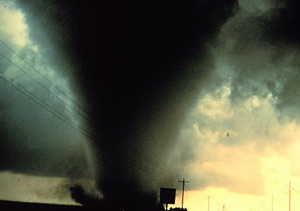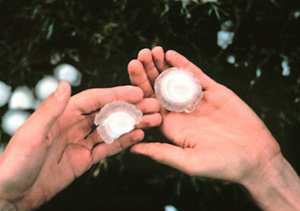NSSL researcher answers the question: "When and where does severe weather occur?"
By Rachel Shortt

Severe weather — strong winds, hail and tornadoes — occurs throughout the United States and the World. However, it is more likely to occur in some areas and at certain times of the year. Harold Brooks, research meteorologist with the National Severe Storms Laboratory, has developed a hazard climatology that helps researchers, forecasters and others know when and where severe weather occurs.
It all began when Brooks attended a meeting with the Federal Emergency Management Agency about tornadoes in Washington, D.C., in 1998. One of the main questions from this meeting was, "How do we determine the real threat of things that are happening and how often should we expect certain kinds of events to occur and where?" This brought about the concept of focusing efforts on understanding the climatology of severe weather.
The study has become a major solution to the problem of how to gather together observations of severe weather, where there are a lot of biases, and take those biases away to produce an estimate that is more believable, Brooks said.

"Once I had started working on it, I also realized I could apply it to lots of things and that it had a way to produce an estimate of the probability on any day of the year on any location in the country that was reasonably defendable," said Brooks. "It was in a statistical way in that we could say, depending on what you believed about the data set, you could apply certain filters to it and get a slightly different answer."
Brooks described his climatology study as being an ideal way to somewhat uncloud the biases that come with predicting severe weather.
"To me, knowing that a tornado happened in Moore, Okla., tells me something about the chance of one happening 10 miles away where we are in Norman, but it doesn't tell me very much about the threat of a tornado happening in Minneapolis," said Brooks. "And the fact that we know when something occurred, say on May 2nd, that's a guide that something could happen on the 3rd or 4th, but not necessarily tell us very much about April 4th. It's almost like looking at something through fuzzy glasses, you don't see all the little details, but you at least know where all the big blobs of color are."

The climatology is available online at www.nssl.noaa.gov/hazard. [Note from the webmaster: A tour of the site follows this story.]